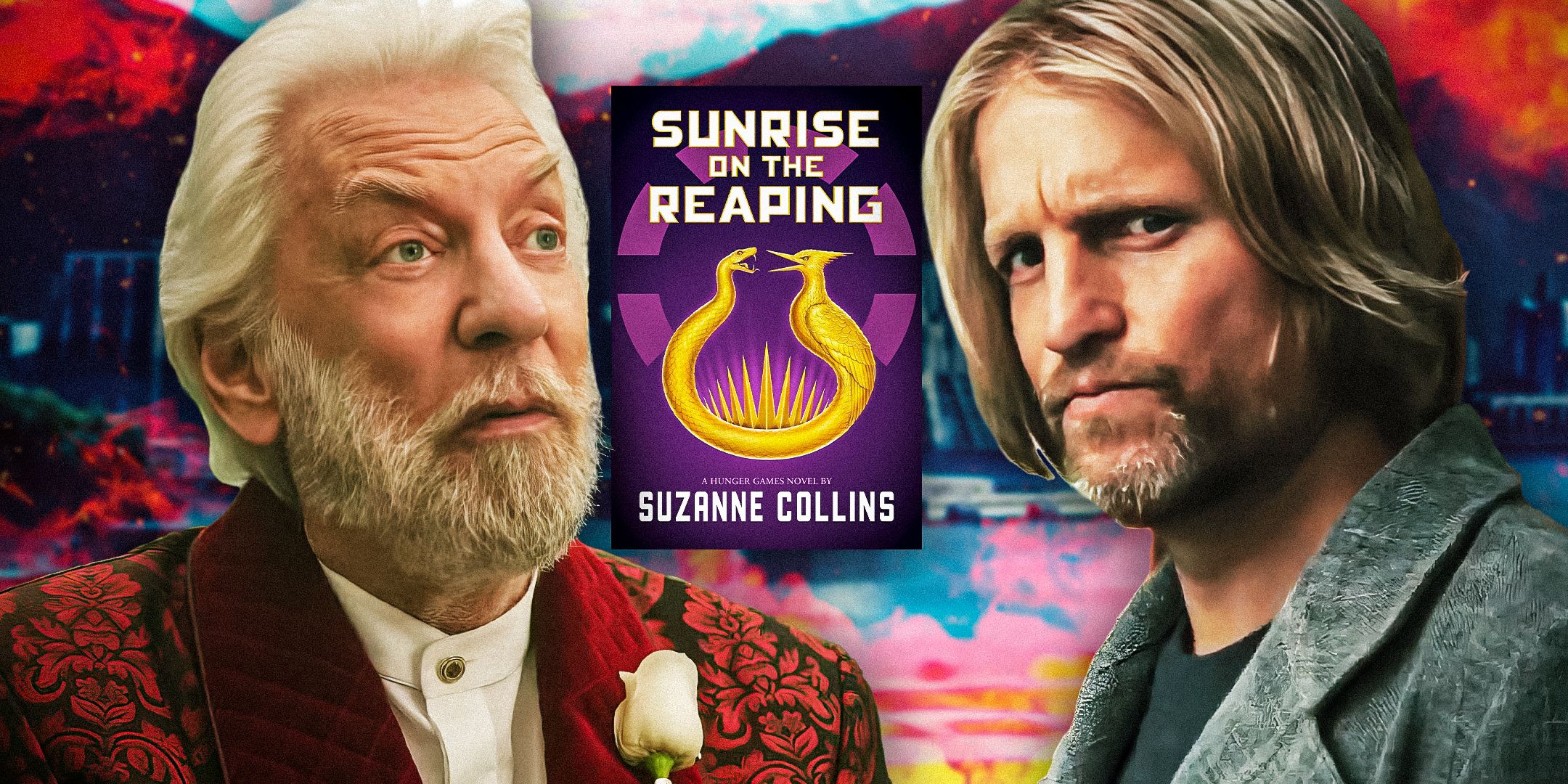Casting For Sunrise On The Reaping - Finding The Right Fit
The air is thick with anticipation when we talk about something as exciting as casting for Sunrise on the Reaping. This part of making any grand story come to life feels pretty special, doesn't it? It's about finding just the right people, those who can truly bring characters to existence. We look for individuals who fit the spirit of the story, making sure every choice feels just right.
Bringing a creative vision into being involves many small decisions, each one building on the last. It's not just about picking names from a list; it's about seeing how different elements might come together, how they might blend or transform. You want every piece to complement the others, creating something whole and wonderful. This process, in a way, is about making sure everything can work together smoothly, almost like making sure different parts of a machine are compatible, so to speak.
And yet, the idea of "casting" goes beyond just selecting actors. It's a concept that pops up in unexpected spots, from how we handle information in a computer to how we share what's on our screens. Each instance, in its own manner, is about changing something from one form to another, or making sure it behaves as expected. It's actually a pretty common idea, even if we don't always think about it that way, you know?
- Dq Valentines Day Cake
- Olive Osmond Cause Of Death
- Jessie James Decker Naked Pics
- Steven Yeun Acceptance Speech
- Eric Stonestreet Movies And Tv Shows
Table of Contents
- What Goes Into Casting for Sunrise on the Reaping?
- How Do We Know It's the Right Match?
- When Things Don't Quite Line Up - Casting for Sunrise on the Reaping
- Are There Better Ways to Approach Casting for Sunrise on the Reaping?
What Goes Into Casting for Sunrise on the Reaping?
When we think about selecting people for a project, it's about more than just a surface look. We need to consider how well a person's natural qualities align with the needs of a part. It's a bit like when you want to change a date from one arrangement to another in a computer system; you check the specific details. I've heard that some computer rules for dates, for instance, might appear similar at first glance, but there are often subtle distinctions. This means paying close attention to the fine points, you know, to get it just right.
Some methods for changing information, like converting it, even offer optional choices for how that change happens. This can help prevent any mix-ups. For example, if you're trying to turn a series of numbers into a proper date, the way you specify that change matters a great deal. It helps everyone involved avoid confusion about what that date actually means. This attention to detail is quite important when you're making choices for something like casting for Sunrise on the Reaping, so it's almost like having a clear set of instructions.
In other situations, when you're working with different kinds of information, you can often change one type to another, as long as they are generally compatible. You might, for instance, see a piece of writing as a general item, even if it has specific words inside. This kind of change isn't magic; it's simply you telling the system that a general item is actually a more specific kind of item. This then lets you work with all the particular features of that more specific item. It's about seeing the potential for a person to embody a more specific character type, even if they usually play a different kind of part, you see.
The act of changing an item's type, in many cases, doesn't actually alter the item itself. It's more about how the system interprets it, how it sees that item. The main reason for doing this kind of thing is to confirm if an item truly belongs to a particular group or kind. This idea is very common in certain types of computer languages because they rely on knowing exactly what kind of information they are handling. So, it's really about making sure the person fits the role, or if they are a genuine example of the character we are looking for when we are casting for Sunrise on the Reaping.
Making Sure Everything Fits - Casting for Sunrise on the Reaping
There are situations where trying to change how a piece of computer memory is seen can lead to issues. It's often not a good idea to try and force a piece of information to be something it's not designed to be. Sometimes, because of how information is organized, a specific way of seeing that information just won't work. I used to think a certain kind of direct reinterpretation was fine for general purposes, like changing memory locations into simple numbers. But when you try to change a very general memory spot into a very specific one, you have to wonder if a simpler, more direct method would be better. It's about respecting the underlying structure, you know?
When you make these kinds of changes in how information is viewed, sometimes a completely new version of that information comes into being. This new version might carry over some of the original details, or it might be something quite different. There are specific guidelines, too, about how you can change one kind of memory reference into another. These rules are put in place to ensure things work predictably. They cover how you can change references to pieces of information into other kinds of references. This is somewhat like how, when casting for Sunrise on the Reaping, a person might take on a part, and in doing so, they become a new version of themselves, shaped by the character.
People have been talking about the best way to change how memory is viewed for a long time. There's been discussion about direct ways versus using a specific helper tool, with questions going back many years. How to properly change one memory reference type to another has also been a topic of interest for quite some time. These are questions that have been asked and revisited over many years, showing how important it is to get this right. It just goes to show how much thought goes into making sure every element, every person, is considered for their suitability when we're thinking about casting for Sunrise on the Reaping.
How Do We Know It's the Right Match?
To truly confirm if someone is right for a specific part, you often need to perform a real-time check. This means, in the moment, seeing if the person you are considering actually embodies the qualities of the character. It's a bit like when a computer system checks during its operation if a piece of information truly matches the kind of information it's supposed to be. This is particularly relevant when you're looking for someone who fits a very particular kind of role, perhaps one that has a long history or specific traits within a larger family of characters. It's about making sure the person truly belongs to that particular character lineage, you know, for casting for Sunrise on the Reaping.
This kind of check is not just a quick glance; it's a verification process. It ensures that the individual possesses the genuine qualities needed for the part, rather than just appearing to have them. It's a crucial step in ensuring that the selected person can genuinely bring the character to life, with all its nuances and particularities. This deep check is what helps us feel confident in our choices, making sure we have the best possible fit for the story. It's honestly a very important part of the entire selection process.
The Inner Workings of Casting for Sunrise on the Reaping
The concept of "casting" isn't some mysterious act; it's you, in a way, informing the system that a general item is, in fact, a more specific kind of item. This then grants you access to all the unique features that specific item possesses. It's about recognizing the particular qualities in a person that make them suitable for a distinct character, and then giving them the opportunity to show those qualities. This is actually a pretty common practice because it helps systems deal with different types of information in a clear and organized way. So, it's about clarity and definition, which is quite useful when we are casting for Sunrise on the Reaping.
The act of changing an item's type doesn't fundamentally alter the item itself. It's simply how the system chooses to look at it, how it interprets that item. The sole purpose for doing something like this is to confirm if the item is an authentic example of a particular group or kind. This is a very common procedure in certain kinds of computer languages because they are built around knowing the exact nature of the information they handle. It's about confirming the genuine connection between a person and a role, ensuring they are truly an instance of the character needed. This makes the selection process for casting for Sunrise on the Reaping more precise, you see.
When Things Don't Quite Line Up - Casting for Sunrise on the Reaping
Sometimes, when you try to share what's on your computer screen with a television, things don't go as smoothly as you'd hope. I've heard that when some people connect their computers to their TVs as a wireless display, they only get the visual picture, but no sound. The sound, it seems, continues to play through the computer's own speakers. This can be a bit frustrating, as you want the full experience. It's like having a performer who looks perfect for the part, but their voice or emotional depth isn't quite coming through, which is a consideration when casting for Sunrise on the Reaping.
I've heard this issue mentioned more than once, with people describing how the visual part appears, but the audio doesn't follow. It's a common complaint for those trying to use their television as a wireless extension of their computer screen. This kind of problem can really affect the overall experience. It highlights that even when something appears to be working, there can be hidden issues that prevent a complete and harmonious outcome. This is something to keep in mind, as a matter of fact, when we consider all the elements that make a performance truly complete.
There are also times when the visual quality itself isn't what you'd expect. Some people have found that when they try to mirror their computer screen onto their TV, the picture can be jumpy and unclear, especially when there's a lot of movement happening on the screen. This makes for a less-than-ideal viewing experience. It's a bit like a performance that looks fine when still, but becomes less clear and perhaps a little disjointed when the action really picks up. This kind of technical hiccup can really take away from the intended effect, which is something we want to avoid when we are casting for Sunrise on the Reaping.
Dealing with Unintended Outcomes in Casting for Sunrise on the Reaping
It's worth remembering that any behavior meant to upset or bother a person or a group of people is a problem. This includes any words or actions that suggest violence or cause harm to another. Such actions can cast a very negative feeling over any shared activity, including something as collaborative as casting for Sunrise on the Reaping. It's important to create an environment where everyone feels safe and respected, where contributions are valued without fear of being disturbed. This is just a basic expectation for how people should interact, you know?
When we look at different ways of changing how computer information is handled, we see that using the same method for many different kinds of changes can sometimes make it unclear what the original intention was. If you use one general term for many specific actions, it can become hard to tell exactly what a programmer was trying to achieve. This lack of clarity can lead to misunderstandings or unexpected results. It's a bit like having a character description that is too vague, making it hard for someone to truly understand the part they are meant to play. Clarity is pretty key here.
Are There Better Ways to Approach Casting for Sunrise on the Reaping?
When we think about how we change information from one type to another, especially in computer systems, there are often different ways to go about it. One suggestion I've heard is that using a method that includes an optional setting might be better than a more straightforward change. This is because the optional setting can help make the intent clearer and prevent mix-ups. For example, if you're trying to turn a series of numbers into a date, having a way to specify the exact format can clear up any questions about what date you mean. This kind of precision helps everyone understand what's happening, which is a good thing for casting for Sunrise on the Reaping.
Understanding the fundamental idea of how one type of information can be converted into another is pretty important. It's a very common concept in computer languages that require strict definitions for everything. This understanding helps us make better choices when we are working with different pieces of information. It's about knowing the rules of transformation, so to speak, and how they apply in various situations. This helps us be more deliberate and thoughtful in our decisions, you see, especially when we are making choices that will have a big impact.
Looking Ahead in Casting for Sunrise on the Reaping
The discussions around how to best change one kind of information reference to another have been ongoing for many years. People have explored direct ways versus using specific tools for these changes. There's a long history of looking at the proper methods for changing references between different types of memory locations. These conversations, which have been active for over a decade, highlight the ongoing effort to refine and improve how we handle these transformations. It shows that even in technical fields, there's always a search for the clearest and most effective ways to do things, which is very much
- Tornado Warning California Scotts Valley
- Who Is Tiny Harris Brother
- Kim Kardashian Lamborghini
- How Tall Is Billy Dee Williams
- Leaked Photos Of Vanessa Hudgens

Every Major Death In The Hunger Games: Sunrise On The Reaping

The Hunger Games: Sunrise On The Reaping Ending Explained

Hunger Games’ Haymitch Prequel Movie Gets Major Filming & Casting